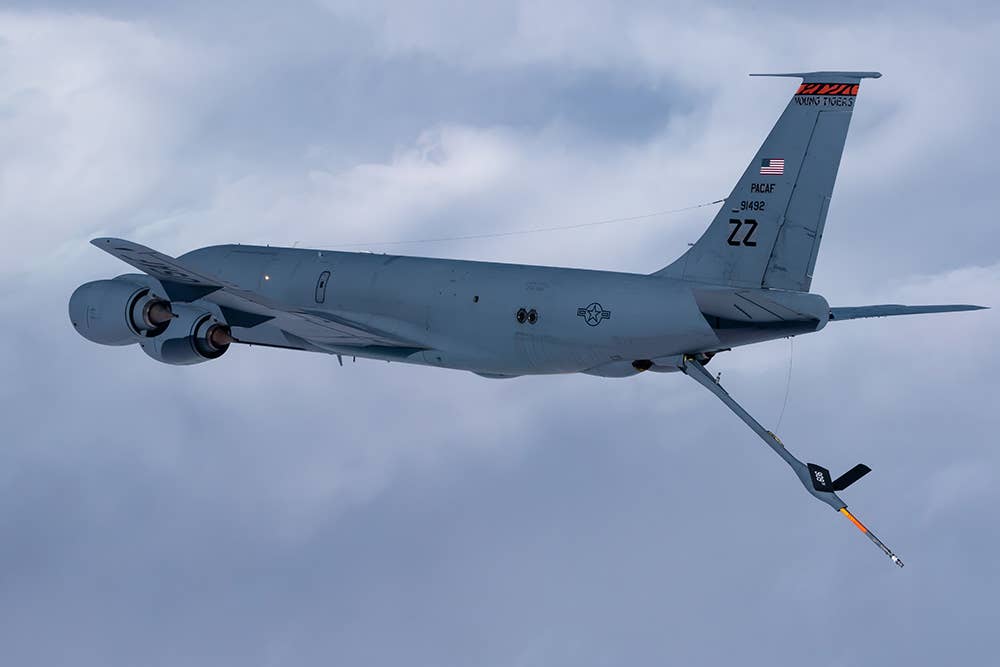Senate Set To Vote On Defense Spending This Week
NDAA could allow the Air Force to retire some of its older aircraft and require the government to take actions to address unidentified aerial phenomena.

Under the current version of the National Defense Authorization Act (NDAA), the Air Force is allowed to retire 18 KC-135 Stratotankers. Credit: U.S. Air Force photo by Airman 1st Class Matthew Seefeldt
The Senate is expected to vote on the National Defense Authorization Act (NDAA) by the end of the week, potentially greenlighting:
- A requirement that the secretary of defense and the director of National Intelligence take actions to address unidentified aerial phenomena (UAP)
- The Air Force to retire some of its legacy aircraft
- A nearly 3 percent pay raise for military personnel and civilian defense workers in the coming fiscal year
Lawmakers could be called to vote on the $777.7 billion national security spending package Wednesday, but the vote could be pushed to later in the week, according to a spokesperson for the Senate Armed Services Committee.
The bill was sent to the Senate for vote after the House affirmed the package on Dec. 7 in a 363-70 vote.
“This year’s agreement continues the Armed Services Committees’ 61-year tradition of working together to support our troops and strengthen national security,” Republican and Democrat leadership of the Senate Armed Services Committee said in a joint statement upon the House vote last week.
“We urge Congress to pass the NDAA quickly and the President to sign it when it reaches his desk.”
What’s In The Bill
The spending package includes authorization of a 2.7 percent pay raise for the military and an overhaul of the Uniform Code of Military Justice, aimed at combating sexual assault.
The bill also requires the secretary of defense and the director of National Intelligence to take actions to address unidentified aerial phenomena (UAP). Last month, the Department of Defense announced it is expanding efforts to detect and identify UAP that could pose flight risks near military training ranges and installations through an expansion of data collection.
Here’s a breakdown of Fiscal Year 2022 defense funding levels:
- Department of Defense: $740.30 billion
- Department of Energy: $27.8 billion
- NDAA topline: $768.2 billion
- Defense-related activities outside of NDAA jurisdiction: $9.9 billion
Under the bicameral, bipartisan agreement, the U.S. Air Force will be allowed to retire some of its legacy aircraft in order to focus its resources on modernization. Lawmakers, however, drew the line at allowing the Air Force to retire the A-10 Thunderbolt II.
The service—which has long attempted to retire the aircraft affectionately known as the Warthog—currently has a fleet of approximately 281 aircraft.
USAF is allowed, however, to retire 18 KC-135 Stratotankers and is required to retire some older C-130s to reduce its Hercules fleet to a total inventory of 279 aircraft.
Also included in the bill are:
- Two C-130Js for the Navy ($197.9 million) and two KC-130Js for the Marine Corps ($197.9 million)
- One E-2D Hawkeye for the Navy ($191 million)
- Two MQ-4 Tritons for the Navy ($323 million)
- Authorization of $4.4 billion for USAF’s F-35A program
- Five Air Force F-15EX tactical fighters ($576 million)
- 12 F/A-18E/F Super Hornets in fiscal year 2022 to mitigate the Navy’s strike-fighter shortfall ($1 billion)
- F-35 B spares ($117.8 million)
A full summary of the NDAA for Fiscal Year 2022 may be found here.

Sign-up for newsletters & special offers!
Get the latest FLYING stories & special offers delivered directly to your inbox






